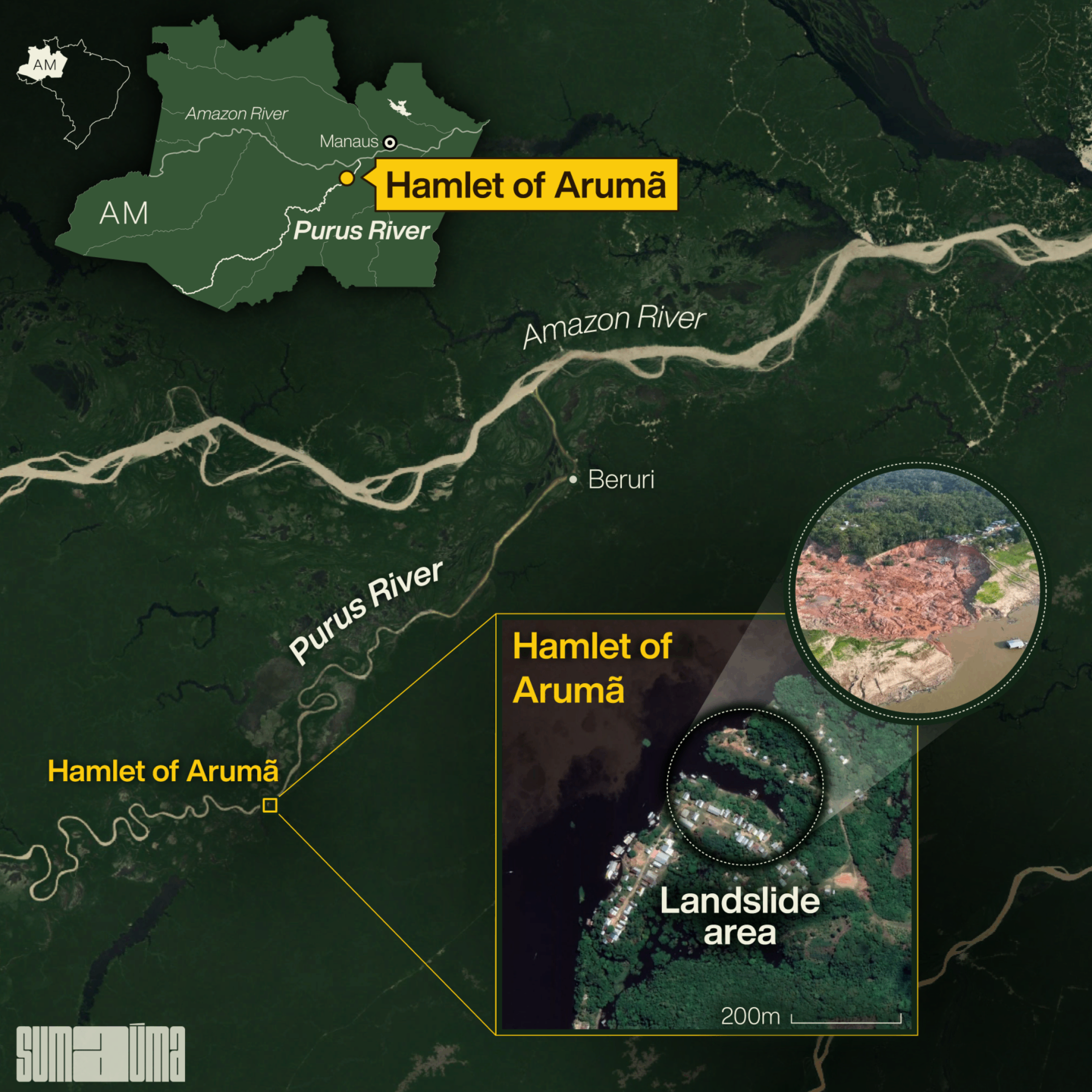On the last step of a wooden staircase near the edge of a river bank at risk of collapsing, Ediel Maciel da Silva, 42, looks at the crater that consumed his village of Arumã, in disbelief. His community had stood for years on this bend of the Purus River, in the municipality of Beruri, in the interior of the state of Amazonas. But the erosion of September 30 sucked everything under the mud and water in minutes. Among those taken was his son, Geiel Vidinha da Silva, who was 16 years old. The stairs are the only memory left of the home Ediel shared with his eight children and his partner Ezivania Aires, 40. The tragedy casts an enduring shadow on their lives. Just two years ago, in 2021, the family’s youngest child, just two years old, died when the stream behind Ediel’s home flooded. In the state of Amazonas, the Silva family is one of the thousands of victims of the climate crisis, a crisis that has made an unsafe situation worse. This situation was known to authorities, but not to residents. How, da Silva wonders, can you lose one child to flooding and another to drought.
The river, which gives life to the community of Arumã and which took Ediel’s children, is also a victim of climate extremes. In the current drought, the Purus, one of the world’s twenty-five largest rivers, is experiencing its fifth most severe drought since the Brazilian Geological Service began measuring the volume of the river in 1967. Last year, the Purus had its worst drought, while in April 2023, it saw its second largest flood. Beruri is among the sixty two municipalities under a state of emergency in Amazonas because of the severe drought. Over 140,000 people have been affected along the Purus River alone, nearly seven times the population of Beruri, estimated at 20,718 people in the 2022 census done by the Brazilian Institute of Geography and Statistics (IBGE).
“There, in this heart-shaped hole, my son is buried… In my mind I see all that despair,” says Ediel. It was the first time he had returned to the site of the accident.
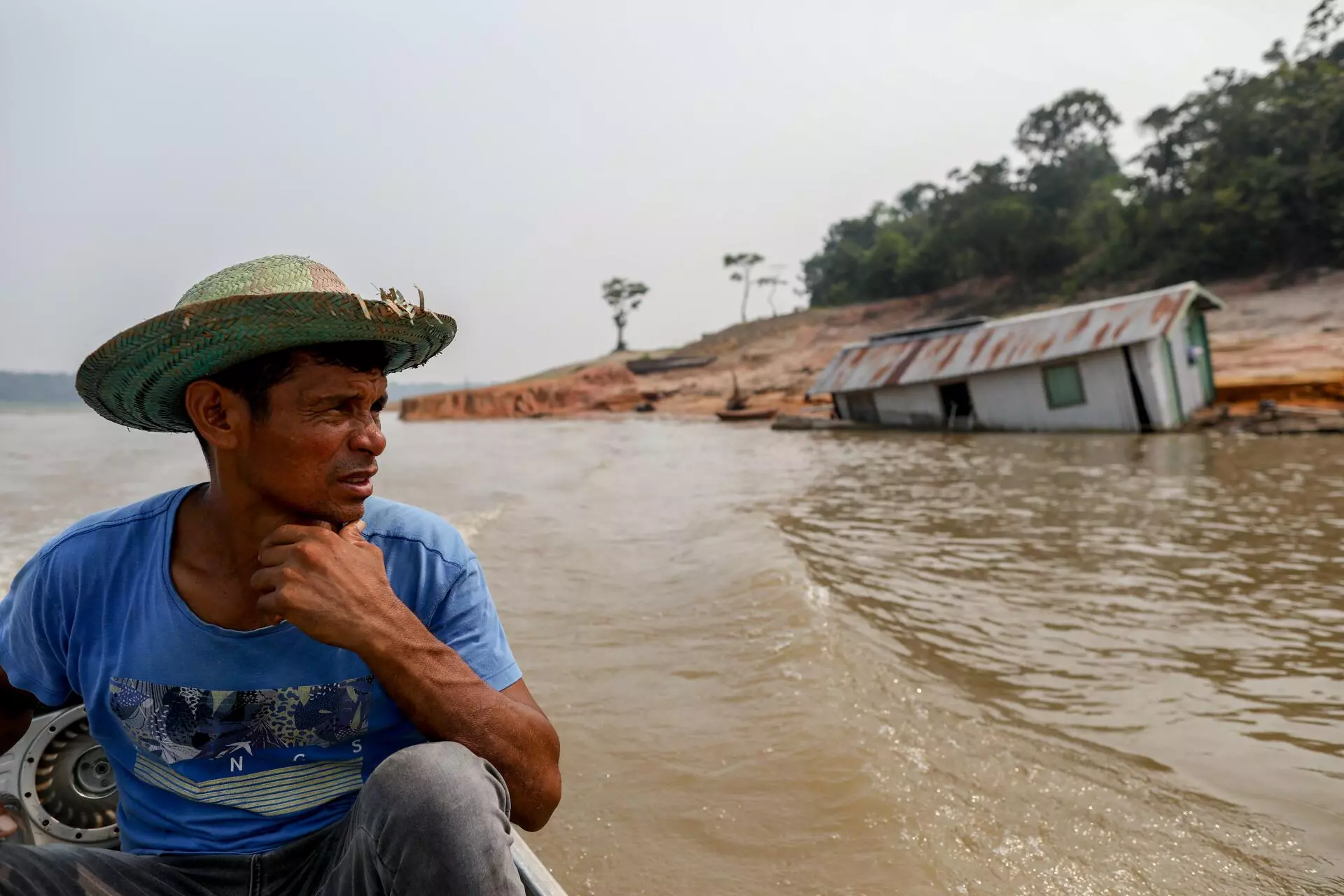
On his first time returning to the site of the accident, Ediel takes in the destruction. He says that after the landslide, he led 200 people through the forest in search of a safe place to shelter
The tragedy in the village of Arumã killed two people and left three missing – all believed dead by their families. It destroyed around forty-seven homes, a healthcare center, a school, and three churches in the small community of ribeirinhos, a traditional forest people who make their living by fishing and farming. Thirty more homes are at risk of collapsing. Around 300 people were left without homes. State and municipal civil defense agencies have not released exact figures on housing in the community or on those affected.
A 2014 report by Brazil’s Geological Service warned of risks to the region. Yet residents only learned that they had been in danger when they watched the news on TV, days after their lives and homes were destroyed. Following the accident and the deaths, the report was made public by the press. The only thing that Beruri’s current administration is saying is that it was not informed by the previous administration.
The survivors feel that nature, unlike public agencies and managers, provided many signals that Arumã was about to collapse into the Purus. Days before the landslide, floors in some homes, at the healthcare center, and at the school cracked. A decommissioned well that had run dry and whose pump was stuck started working again.
“Valmir [a neighbor] told me: ‘That pump there was stuck, I pulled it and it moved.’ The church’s windows were tight to shut. At Rei’s, at Nivaldo’s, at Mauricio’s [other residents] houses too. The floor had split at the school and the health center. The land was doing this [forms an inverted pyramid with his hands],” says Ediel at around 8:00 PM on October 11, while chatting with four brothers from the Freitas family, on a floating structure just a few meters from what is left of the village.
The family’s oldest brother, Eliezer Freitas, 30, agrees: “The land was shrinking downward. There were so many signs and nobody realized it.” The Freitas brothers, whose homes occupied nearly an entire street in Arumã, now spend the night on a small wooden boat. Hammocks are hung inside. It’s all they have to begin again. “If only someone who understood this had come and said: get out of there. But we never imagined,” Ediel said.
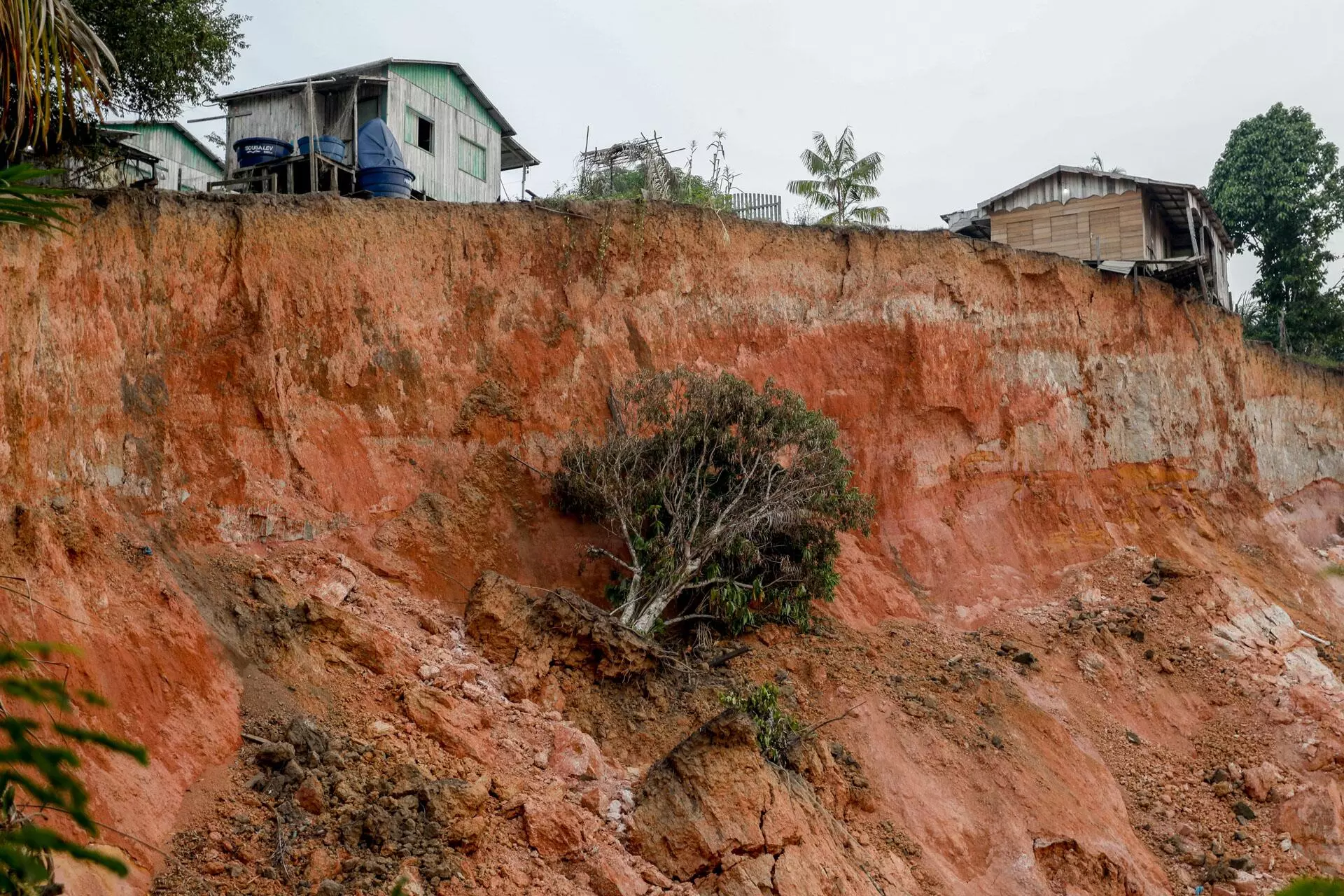
The landslide swallowed 47 homes, three churches, a healthcare center, and a school, while also leaving two people dead and three missing in the Purus River
It was 3pm on Saturday, September 30, when the signs grew more evident. Earth began falling from the river’s slope. Because land sliding into the river (from erosion caused by the river’s movement along the banks) is a common sight, this was seen as a normal occurrence. Residents rushed to shoot videos with their cell phones. They included Ediel’s son, Geiel. The teenager didn’t have a phone and wasn’t tech-savvy.
He preferred being in the countryside and playing football. But one month earlier, his parents had installed higher speed internet and Geiel began using his mom’s mobile.
By 6pm the village was typically vibrant with kids playing in the streets, fishers arriving home from the river, and people conversing in front of their homes. At this time of day, fisher Ketla Paiva Moura, 30, would usually have been further from the site of the accident, at her own floating home, but she had stayed at her father’s house. Her children, Kezia Moura Lima, 16, and Allyson Moura Lima, 7, were helping their grandfather wind up the ropes he sells from the floating structure where he lives. From the bottom of the river’s slope, Ketla and her children didn’t see the bustling of the residents when the bank began to give way.
On the floating home next to Ketla’s father’s house, Maria do Socorro Barros da Silva, 57, was frying chicken for dinner with her husband, Maurício Barros. While brothers Elizeu and Eliezer Freitas were returning from a full day of fishing, returning with enough of a haul to eat and to sell. Guessing they would profit at least R$ 1,000, they were unaware the land had started to give way.
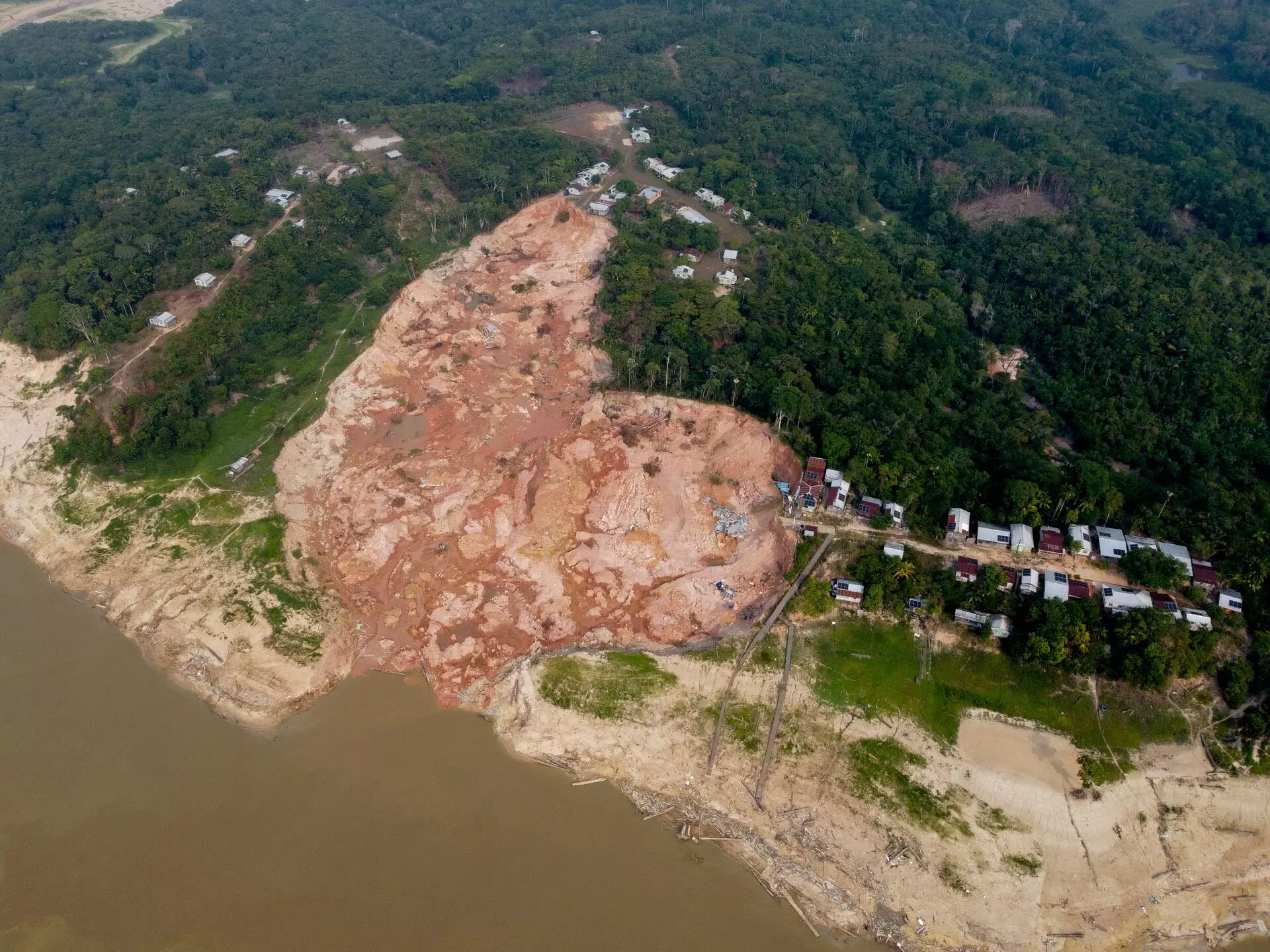
Nature provided many signals that Arumã was about to collapse into the Purus. A 2014 report from the currently the Geological Service of Brazil warned of risk in the region, but residents were never warned
Residents gathered in front of the river bank to see what was happening. Ediel saw the first part fall, at the lowest point on the river’s slope. He had enough time to quickly get his parents off the floating home where they lived. But at sunset, the earth roared.
A larger part of the village collapsed all at once and formed a huge wave in the stretch of the Purus in front of Arumã. Residents reported that it reached five to seven meters high. The floating structures in front were the first to be hit. It was then that Ediel’s son ran to film the event. Neighbors told his dad they saw the ground crack, with the front part, where Geiel stood, collapsing.
Unaware of what was happening to his son, Ediel heard the boom and saw the bank collapse. He ran through the land next to the sunken area, the path he would usually take when he arrived at the village from the river. He saw family members and neighbors. Along the way, he saw Elizeu’s seven-year-old son, anguished and praying on his knees, hands lifted to the sky, along with a pastor and other church members. He yelled at them: “It’s not time to pray anymore, now it’s time to run.” Later Eliezer said that “the pastors were outraged at the time. But even if it were the most devout person, God wasn’t going to answer anyone there.”
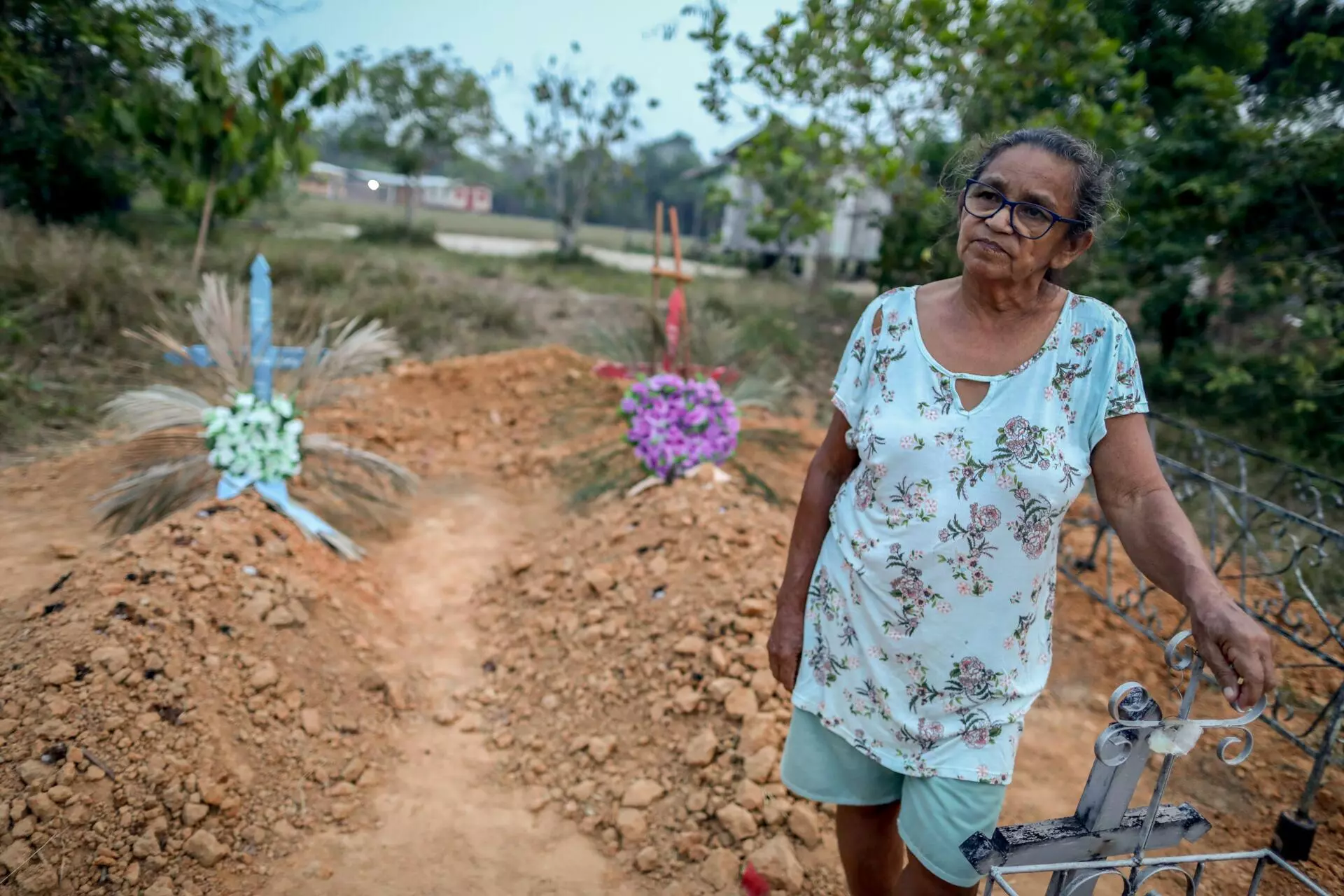
Farmer and fisher Maria Perpétua Nazaré Laborda, whose great-grandnephew and great-grandniece died in the accident. ‘Now we look down there and it’s just loneliness’
Ediel says that for around an hour he led over 200 people into the forest. It’s usually a twenty-five minute walk to the land where he grows fruit and vegetables. The dense forest made the trek difficult and there were children and elderly people who feared being swallowed by the earth.
On a floating home in front of the village, fisherwoman Ketla and her two kids were getting ready to go home in their canoe when the force of the water knocked her into the river and pushed her two children in different directions. Ketla felt her strength leave as she was sucked to the bottom of the river by a whirlpool. She felt pieces of the floating home hit various body parts, while she swallowed water and mud. She says she only survived because all she could think about was saving her kids. “The wave was strong. I thought I wouldn’t make it. I only managed to come up because I was thinking of my two darlings. I needed to find them,” she says haltingly, the words wet with tears, at a speed opposite to the rapid events of September 30.
The huge wave spilled to the sides and hit other floating structures. At Socorro and Maurício’s floating house, it knocked over furniture, shelves, and the couple too. Their house was pushed onto land, to a height it could only reach after flooding. Moments later, the houseboat was thrown down the riverbank by a second wave. “We saw that big wave coming. It seemed like it would swallow us up, it came into the houseboat and threw us. Everything fell, from everywhere. A horror movie,” recalls Socorro, rubbing her forehead, her brow furrowed, staring at the kitchen floor.

Personal objects, pieces of wood, solar panels, and other parts from the homes were carried by the current and can be found up to an hour away from the site of the tragedy
The Freitas brothers were preparing to anchor their canoes when the wave reached them. They were a few meters from the erosion. When the wave washed back up onto the land, it uncovered a rock outcrop in the river that can only be seen during the worst droughts. “It was a wave like I’d never seen. I think some five, six meters high. It seemed like a living thing, rocking and growing,” says Elizeu.
He tried rowing, but found it was in vain. He was then thrown on to land, where he ran to escape being swept back by the water. From there, he watched Arumã collapse. “I stood on dry land watching everything, not knowing what had happened to my family. I saw the steep wall along the river fall, the whole scene. The houses disappeared and there was a boom. I lost hope. I thought it was all over.”
His brother, Eliezer, was in another canoe with his four-year-old son. “I gripped my baby boy’s hands. I said, ‘my God in heaven, I’m never going to let go. We’ll both die.’ The wave came, hit the rock outcrop, and its strength dissipated. It came over us weaker and spread out.”

The photo at left shows the remains of the destruction. At right, animals abandoned by the victims, who had to leave after the landslide
When the river’s violent movement slowed, Eliezer heard a woman’s voice yelling: “My son!” It was Ketla, clinging to a piece of wood. “We asked if she wanted to go to the shore and she said: ‘I want you to find my son.’ That thing had taken her son from her hands. Her daughter had disappeared too. There was nothing we could do and we were desperate to find out about our family, if they had died too,” he recalls.
Ketla only got out of the river with the help of Ediel’s father after her son floated nearby where his mother was waiting for him. Two days later, firefighters found the body of her 16-year-old daughter. Kezia and Allyson were buried in the village’s cemetery.
While she was still in the river, the Freitas brothers climbed the bank on the same side of the river as Ediel. “When I started walking, I saw the house wasn’t there anymore. And the horror was happening. The land sliding. It made me sad to see the school, the Catholic church, which was all decorated, disappearing” says Eliezer. Holding his son tight, he said it hurt to see his mother’s house, which she had recently painted, swallowed by the mud. In his own home, which “lacked nothing,” the family was waiting for the gas to run out on their old stove before debuting their new one. They lost it all to the disaster. He said that when he reached Ediel’s land, he wept with relief as he embraced his other children and his wife.
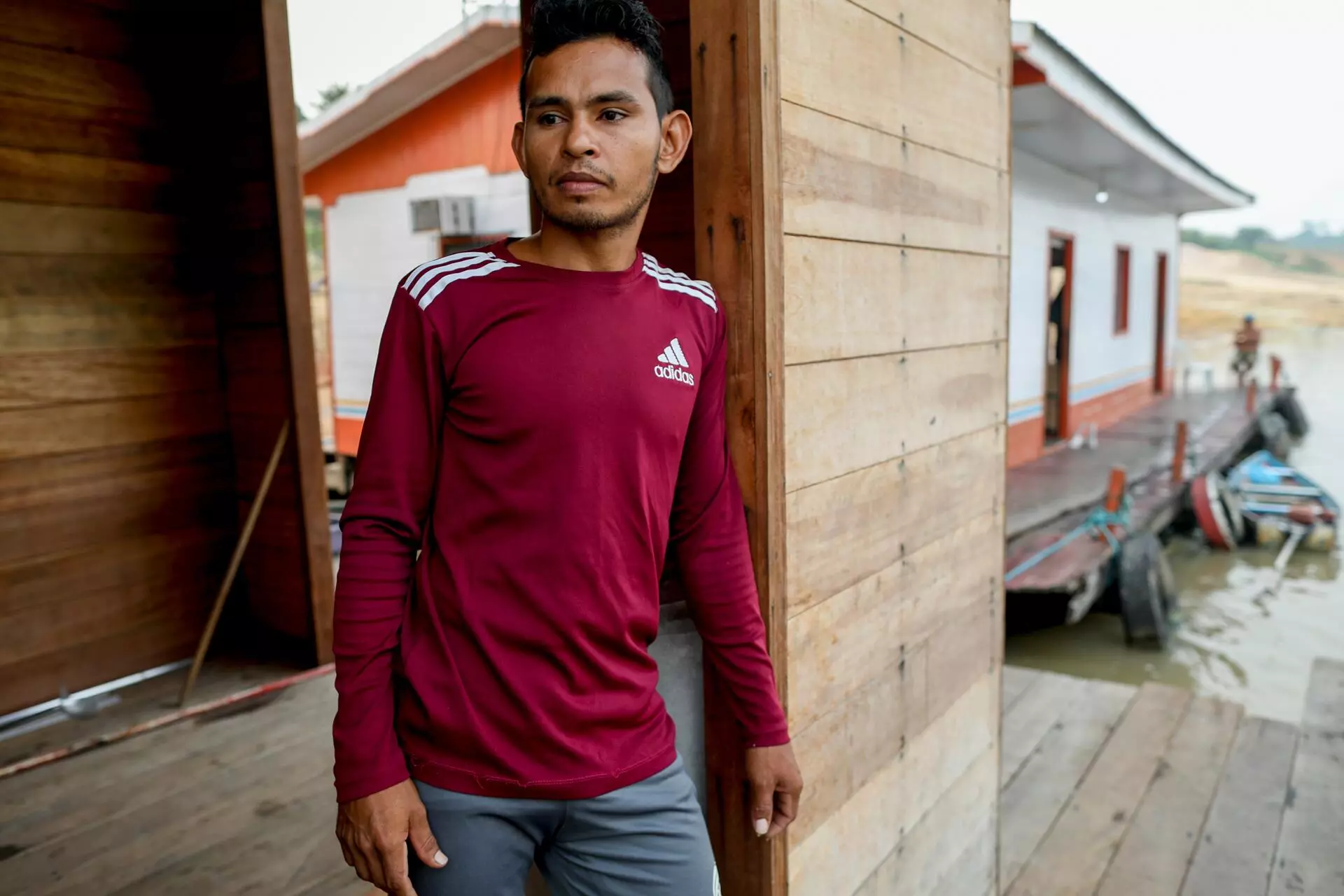
Carpenter Edclei da Silva Carneiro is overcome with emotion remembering his father, one of the people who disappeared. Residents considered Raimundo to be ‘the best baker in the region’
Elizeu felt sick along the way, his body shook and he gasped for air. “I was trying to control that fatigue and all that disturbance in my mind. That crying of people, the booms. All night long it troubled my ears. Every once in a while, we remember and that scene of it all happening comes back. That screaming of people.” He told how he slowly reached the place where he found his wife, kids, siblings, and parents.
On the trail where Ediel was leading residents fearing for their lives, people were helping each other, crying, and shouting prayers asking for divine mercy. The only way to quench their thirst along the way was to use a dirty diesel fuel jug to bring water from a water-hole (dug in the ground for temporary access to water) to a shack that had only a floor and a roof. The lid became a cup. Ediel tells how mothers were praying and giving water to their kids to drink.
First responders only arrived in the early hours of the morning from Beruri, after a five-hour trip because of the low tide. Lacking structure, the municipality needed help from a businessman, who provided boats and employees to support the community. Nobody wanted to leave for fear that the land would keep sliding.
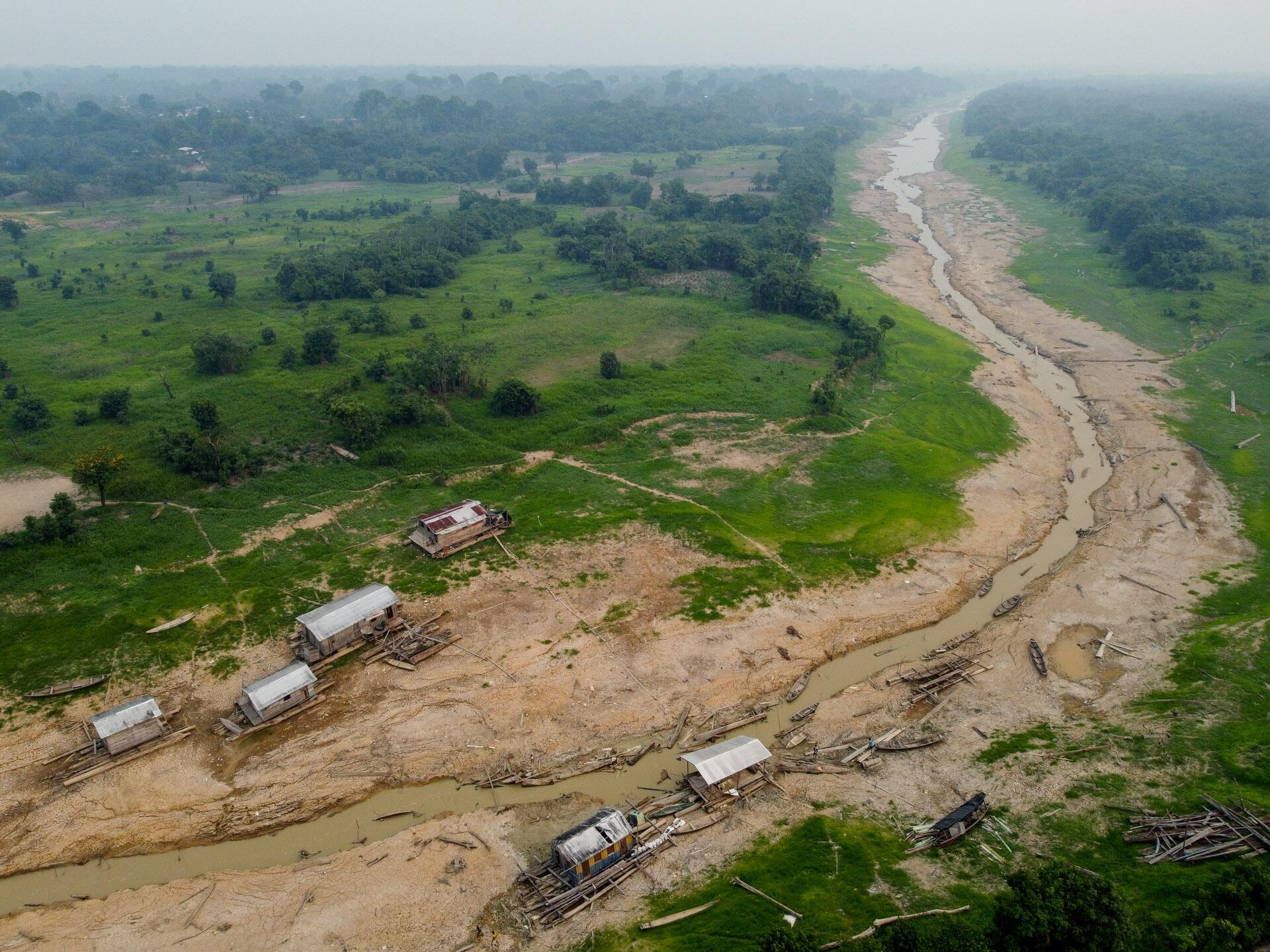
An aerial view of Beruri, which is suffering from a severe drought and from smoke from illegal forest fires. Some families from Arumã who were left without homes are staying in city
Besides Ketla’s children and Ediel’s son, the community also lost Raimundo Cordeiro, a baker. He had stepped outside of his house to watch the bank fall. But first he removed two of his grandkids from the edge of the bank. One of them was Elizeu’s son, who had knelt to pray when the accident happened. The boy told his father that he watched as the land swept his grandfather away.
The community also lost Raimundo Furtado da Silva. Years earlier he had been bitten by a snake and had lost a leg. He lived alone. “He was disabled. I didn’t remember. Nobody remembered. If I had thought about it, I would have carried him,” Ediel says sadly.
Already swallowed up by the earth and by indifference, the residents now fear losing their way of life. It’s like Eliezer says: “I could live in the richest, most beautiful place in the world, but the best place was there, I wish it could all come back again. I’m asking God to show us where we will be OK.”
CLIMATE CRISIS INTENSIFIES THE ‘FALLING EARTH’ PHENOMENON
Jacqueline Sordi
Erosion along the banks of the Amazon’s rivers, a phenomenon popularly known as “falling earth,” is common along the slopes of many of the watercourses that flow through the world’s largest rainforest. Nevertheless, this erosion is becoming more and more frequent, intense, and lethal because of climate change. This was the case of the landslide that wiped part of the village of Arumã from the map. “We are positive that climate change is directly related to this scenario,” says José Alberto Lima de Carvalho, a geographer and professor in the Geography Department at the Federal University of Amazonas (UFAM).
The Amazon region is currently experiencing one of its most severe droughts ever, according to official measurements, and this is where the imprint of climate change is most evident. For climatologist Carlos Nobre, a member of the Brazilian Academy of Sciences (ABC), there is no question that the current drought in the Amazon should be considered an extreme climate event and that it is directly influenced by the planet’s warming. Experts say that 2023 is among one of the hottest – if not the hottest – years on record. Add to this a world under the effects of El Niño, a phenomenon that involves the warming of the Tropical Pacific Ocean and the behavior of the winds, changing rain patterns in various regions of the planet. In relation to Brazil in particular, it makes rainfall more frequent and intense in the South region and usually causes below-average precipitation in the Amazon region. The Earth’s heating has a direct impact on how intense an El Niño is, because the warmer the ocean waters are, the stronger the climate phenomenon becomes. This year, water temperatures in the Tropical Pacific Ocean are above average and are also moving toward a historical high. “In other words, if we had the strongest El Niño on record in 2015 and 2016, all signs point to this record being broken,” says Nobre.
And it doesn’t stop there. The planet’s heating is also affecting the Northern Tropical Atlantic Ocean, where high water temperatures in recent months have contributed to an even greater drop in precipitation in the world’s largest rainforest. This whole complex scenario is influencing the extreme drought in the Amazon. Yet we cannot forget a fourth and important factor, which is deforestation. From 2015 to 2022, over 50,000 square kilometers were deforested in the Amazon. “If we look at data going back to 2015, we find that deforestation has increased significantly in the last three years. From 2019 to 2022, it exploded,” says Nobre. Deforestation in the Amazon is not only contributing to rising greenhouse gas emissions, but is also worsening the drought, because when pastureland replaces forest, it makes the soil more compact, which makes it less able to absorb water. This drastically reduces the evapotranspiration process, or rather, the forest’s release of water vapor to form rain – which is so important in times of drought.
Report and text: André Duchiade and Catarina Barbosa
Fact-checker: Plínio Lopes
Proofreader (Portuguese): Valquíria Della Pozza
Spanish translation: Julieta Sueldo Boedo
English translation: Sarah J. Johnson
Photo Editor: Lela Beltrão
Layout and finishing: Érica Saboya
Editors: Malu Delgado (chief reporter and content editor), Viviane Zandonadi (editorial workflow and copy editing), and Talita Bedinelli (editor-in-chief)
Director: Eliane Brum
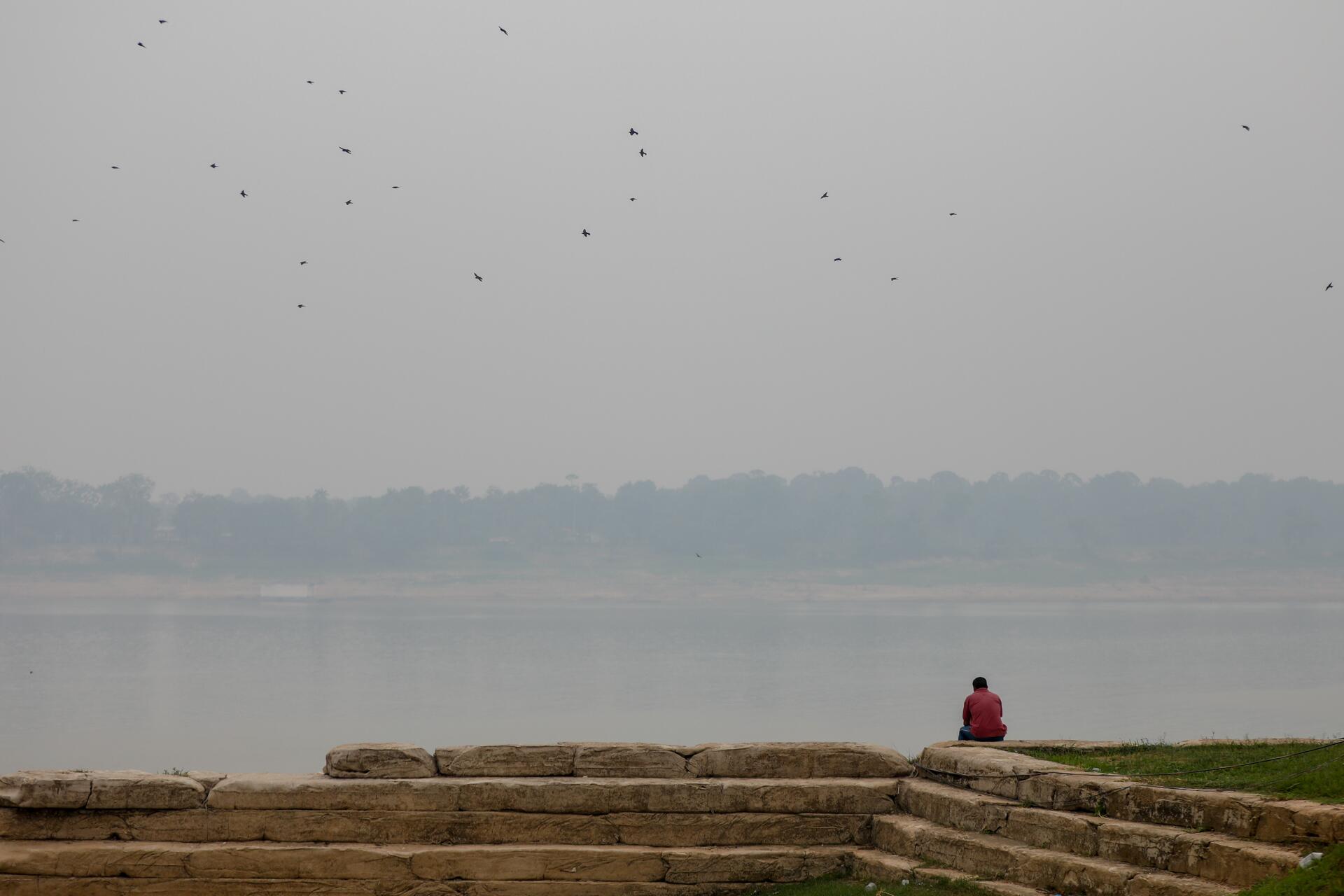
According to Marcelo dos Anjos, a biologist, it isn’t natural processes or weather phenomena that are making life in the Amazon more fragile, but a lack of public policies that respect the environment and are adapted to human life in the region




